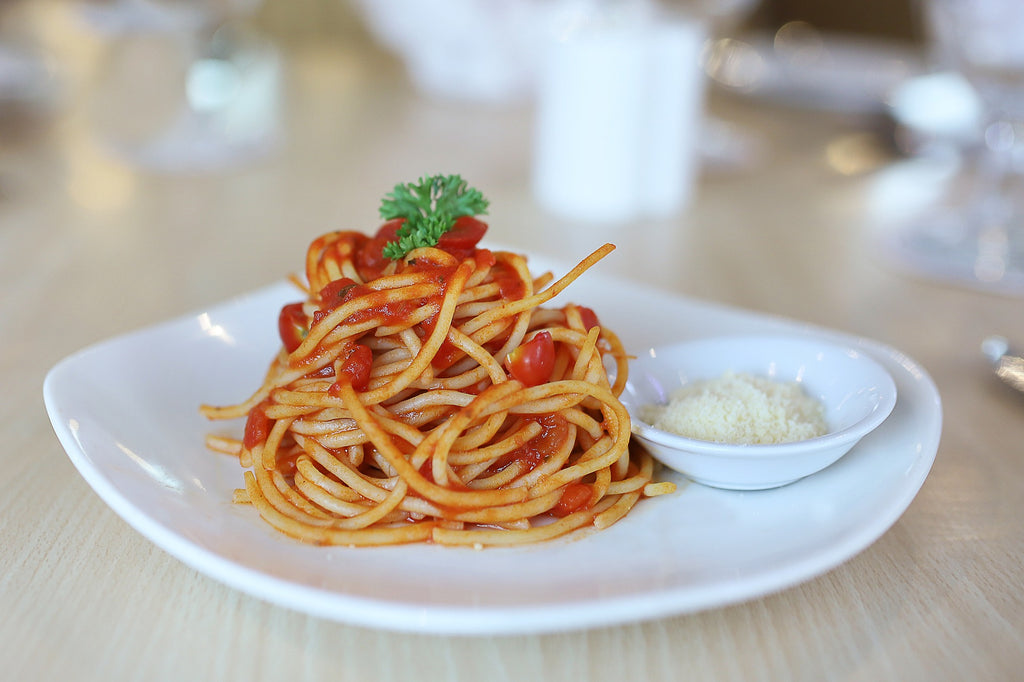One of my pet peeves with Americanized dishes claiming to be Italian is the greasy, chunky “marinara” sauce that many restaurants offer as an alternative to the also inauthentic “alfredo” sauce with pasta or served as a dipping sauce with fried cheese sticks. Heartburn on a plate, I call it.
I ordered that not long ago because it was the only thing a vegetarian like myself could eat on the menu. I could barely get through it. Big chunks of onions swimming in bright red grease that flung onto my shirt and drowned the overcooked spaghetti. This is what we have come to think of as “Italian” cuisine. It hurts my heart!
The good news is, in Italy there are some absolutely fabulous tomato sauces that will put those greasy ones to shame. More good news? They are so simple, once we know how authenticity tastes, we can much more easily replicate it to serve to our own families.
So, if the greasy chain restaurant stuff is not authentic, what is? What can we expect to find in Italy that tastes so much better that we want to make it for our loved ones?
We’re here to explain some of the most common red sauces you will encounter in Italy, the best pastas to serve them with, and the differences between them.
Marinara: True marinara as a word and sauce, is thought to have originated in Naples from the fishermen who would have eaten simple ingredients that were easy to take with them and that would not spoil too easily. Ingredients like olive oil and tomatoes would have allowed them to prepare a sauce to have with whatever fish they could catch that day.
Whether true marinara has to have fish in it is debated. To be completely honest, in my experience in Italy, the few times I have seen marinara on a menu, it has always been a seafood dish. Usually a little bit of pasta with a lot of shellfish and a red sauce, but a much lighter (and better) one than what we think of as marinara here in the states.
Show a Neapolitan native a “marinara” sauce we would dip a cheese stick into, and there would be cringing and shouting and hands flying everywhere. After you experience the authentic version, you’re likely to behave the same way when faced with an imposter!
For a seafood pasta dish with red sauce try Mia Emilia’s La Pasta di Aldo Maccheroncini Egg Pasta.
Ragu`: Without a doubt, one of the most common and beloved Italian red sauces is a Ragu`. Ragu` is what we typically think of when we picture Mamma or Nonna in the kitchen, slow cooking a sauce for hours on end. Typically, it is a red sauce with meat, and you will see different versions all over Italy.
Some regions or homes will cook ragu` with a large piece of meat and then remove the meat, serving it separately. You will often find wild boar, rabbit, and other varieties of meat in the really authentic ragu` sauces.
I cannot hear ragu` without cracking a smile. If you have ever been around Italians or Italian descendants you have undoubtedly heard, “My nonna made the best…”. Odds are this is what they were referencing. Many a Mamma and Nonna are said to make the best version, and often these recipes are passed down generation to generation, so they are typically incredibly good.
For your own ragu`, we recommend Mia Emilia’s La Pasta di Aldo Pappardelle.
Arrabbiata: A favorite word of mine in Italian is arrabbiata, angry! Isn’t it fun to say? Arrabbiata sauce is “angry sauce”, meaning it is spicy. Arrabbiata combines olive oil, tomatoes and garlic with red chili peppers to give it a spicy kick that is delicious and authentic. Typically, Arrabbiata is considered to be a Southern Italian dish. If you like spicy food, give this a try!
Try it with Mia Emilia’s Spighe Molisane Durum Wheat Semolina Pasta, Cavatelli Cercesi.
Amatriciana: You may remember hearing a few years ago about an Earthquake in Amatrice, a city in Northern Lazio. Amatriciana literally means, “from Amatrice” and it gained a new love after the city was so badly damaged by the earthquake. Amatriciana is made with guanciale (pig’s cheek), and pecorino cheese, along with the olive oil and tomatoes, and sometimes chili pepper.
Excellent with Michelis Egiio Tagliolini Egg Pasta.
Puttanesca: A very savory recipe deriving from a quite unsavory word. There is no shame in enjoying the pasta dish! You are very likely to come across this dish in Italy, especially in the Southern regions. It is typically made of tomatoes, black olives, capers, and anchovies along with garlic and sometimes a little bit of red chili pepper to add some spice. Different versions eliminate anchovies or call for other ingredients. The common ingredients always present are the tomatoes, garlic, capers and olives.
Try it with Mia Emilia’s La Pasta di Aldo Filini Egg Pasta.
Pomodoro: This one is my favorite, because it is the simplest, and to me the freshest tasting. If you see a pasta pomodoro on a menu in Italy, expect a fresh tasting sauce the color of a real, ripe tomato. A true, Italian Pomodoro sauce often begins with soffritto: finely chopped celery, carrot and onion fried in extra virgin olive oil. Then, San Marzano or other sweet tomatoes are added in. More often than not, Italians actually use canned tomatoes for this, and I actually recommend doing the same to recreate it here. Don’t fall for the cheapest jar on the shelf, though. Spend a little bit more to buy the good ones, made in Italy, and never marinated.
Enjoy the simple pomodoro sauce with your favorite Mia Emilia Pasta, it is good with any shape.
What all of these sauces have in common is their simplicity and quality of the ingredients they use. Pick up a jar of pasta sauce on the grocery shelves and you’re likely to lose count of the ingredients and find several you can’t even pronounce.
Authentic pasta sauces in Italy are simple and made from pure ingredients packed with nutritional value. It’s not only the flavors of Italy that delight us, it’s also the way they enjoy them. Slowly, and together.

